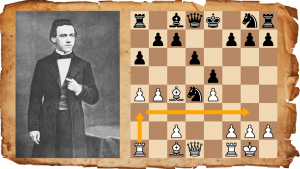
The Indian Roots Of Modern Chess
I recently read an interesting article in Time, written in 2008 by then-world champion Viswanathan Anand, in which he argues that chess originated in India, and then traveled westward to Persia and ultimately to Spain.
In the elegant final paragraph, Anand writes that "...my own career has in some ways mirrored the journey of chess. I learned to play in India, then moved to Spain so I could play the European circuit, and won my first world championship in Iran. It's nice when your place in chess history has something to do with the bigger picture."
While Anand's argument is compelling, he doesn't mention what was perhaps the second-biggest historical influence from India on chess, namely the arrival of the so-called "Indian Defenses."

Vishy Anand. | Photo: Maria Emelianova/Chess.com.
Although most chess players are, of course, familiar with these Indian Defenses (or "Indian Games"), the origin of the name is much less known. First referenced as such in the late 19th century, the name was popularized in the 1920s by Savielly Tartakower, who in his influential book Die Hypermoderne Schachpartie (1924) classified the openings starting with 1.d4 Nf6 2.c4 into "Old Indian" (...d6 and ...g6) and "Neo-Indian" (...e6 and ...b6).
As we know, these encompass most of the semi-closed openings still played today at the highest level, such as the King's Indian, the Grünfeld Indian, the Nimzo-Indian and the Queen's Indian.
But why are they called "Indian"at all? For that, we need to go all the way back to the middle of the 19th century—to Calcutta (now called Kolkata), the capital of the region West-Bengal, India, to be precise. The year is 1850. The British East India Company ruled over most of India, but the "British Raj" (or Indian Empire) would only be established seven years later.
In 1850, Paul Morphy and Wilhelm Steinitz were still teenagers, not yet 15 years old. But John Cochrane, a Scottish lawyer (b. 1798) who had published several popular books on chess and had played on more or less level terms against the best players in the known world (such as Staunton, Deschapelles and De Labourdonnais), was stationed as a barrister in Calcutta.
Cochrane had been in India earlier during his career, and at the time of his tenure at the Calcutta bar in the 1840s and the 1850s, he became president of the Calcutta Chess Club. (Around this time, he also invented the piece sacrifice in the Petroff Defense that still bears his name: 1.e4 e5 2.Nf3 Nf6 3.Nxe5 d6 4.Nxf7!?, known as the Cochrane Gambit.)
Cochrane had beaten everyone at his chess club and was yearning for stronger opponents. His prayers were about to be answered.
In 1848, an obscure Brahmin man from a local village (mofussil), named Moheschunder Bannerjee, was introduced to Cochrane. The story of how Bannerjee Moheschunder (or Mahescandra, as his name is sometimes written) came to the Calcutta Chess Club has been beautifully described in an (anonymous) letter to The Chess Player"s Chronicle in 1851:
Until the early part of last year, Mohesehunder had never been twenty miles from his native village in the Mofussil, as the interior of India is designated. He had never played with a really good player, and was scarcely acquainted with all of the European rules of the game. From long continued and uninterrupted success, he had become desperately self-sufficient and obstinately addicted to certain faulty styles of opening, of which indeed he is not even now cured.
The introduction of Mohesehunder to Calcutta was on this wise: —A member of the Calcutta Chess Club, during a Mofussil pilgrimage in the autumn of 1848, heard of the fame of this local Philidor, and learning further that the Mofussil Champion had " never been beaten," he rejoiced exceedingly, in the prospect of beating him soundly ! This expectation was not destined to be fulfilled; for our Brahmin triumphed. The discomfited club-man thereupon brought him down to Calcutta, and requested Mr. Cochrane to take him in hand. Now Moheschunder had never even heard of Cochrane, nor, for that matter, of Ruy Lopez, Philidor, La Bourdonnais, Macdonnell, or Staunton!
(You can read the entire letter in this well-researched article by "Batgirl" for Chess.com. The letter also explains that under the Indian rules of chess, only the central pawns were allowed to move two squares initially, and that capturing en passant was not allowed.)

John Cochrane.
After being appointed as a "paid attache" at the chess club, Moheschunder played Cochrane dozens of times over the course of the following years, and he seems to have steadily improved his play (Cochrane did win the majority of them.) Many of the games played by Moheschunder and some of his other countrymen were recorded by Cochrane. And it is among these games that we find the first examples of the "Indian Defense."
As W. Sergeant wrote in 1934:
The Indian Defenses (...) were largely taught to European players by the example of Moheschunder and other Indians, to whom fianchetto developments were a natural legacy to the game.
This "natural legacy" was essential for how the Indian Defenses came into existence. Here's the very first example I could find of Moheschunder playing an "Indian" kind of defense:
A year later, Moheschunder had devised a much better version of his opening idea. Lo and behold the first King's Indian Defense of all time:
Cochrane and Moheschunder fought dozens of battles in the King's Indian over the course of several years. Playing through these games, I found it incredible how well Moheschunder understood the basic concepts in this opening—concepts which are still valid today. Take a look at this position from a game played in 1855:
I find it absolutely astonishing that this position, which still looks completely natural and harmonious to modern eyes, was played before Morphy and Steinitz had ever played any chess games of significance. And at the same time, it's infinitely regrettable that the very same Morphy and Steinitz never had an opportunity to absorb and integrate these concepts into their own chess development.
Moheschunder was also responsible for the first occurence of the Grünfeld Indian:
The Grünfeld Indian Defense is perhaps the best-known example of a "Hypermodern" chess opening. This chess movement started in the early 1920s and emphasized long-range control over the center rather than direct occupation of the key squares, exactly the same concepts as Moheschunder and other Indian players preferred 70 years before.
(In fact, Moheschunder also played these setups with White, often starting out with 1.Nf3, 2.g3, 3. Bg2 and so on. This setup remained unpopular until Mikhail Chigorin started developing his king's bishop in the same way in the last quarter of the 19th century. Later, Richard Réti perfected the setup by introducing, after 1...d5, the sharp move 2.c4!)
Let's move on to the opening that bears the name of perhaps the greatest hypermodernist of all: Aron Nimzowitsch. Yep, you've guessed it: the Nimzo-Indian was also first played by Moheschunder! Here's the game in question:
As if all this isn"t enough yet, Moheschunder also played the first Pirc Defense known to us: 1.e4 d6 2.d4 Nf6 3.Nc3 g6 4.f4 Bg7 5.Nf3 0-0 was seen several times in his games. He also was the first to try the somewhat notorious ending arising after 1.e4 d6 2.d4 Nf6 3.Nc3 e5!? 4.dxe5 dxe5 5.Qxd8+ Kxd8.
Finally, Moheschunder seems to have also been the first ever to have tried "proper" Nimzowitsch Defense-type of closed positions: 1.e4 Nc6 2.d4 d5 3.e5 Bf5 followed by Qd7 and f7-f6, which is today is still the most principled way for Black to play the Nimzowitsch.
But that's not all. Another Indian club member of Moheschunder, a player who only seems to be known by the name Somacarana, played what's arguably the first instance of the Caro-Kann Defense against Cochrane:
This game was played 36 years before Horatio Caro himself played the opening (against Von Bardeleben, in Berlin, 1886).
As chess history would have it, most of the Indian opening ideas above weren't picked up by leading players in the West until the hypermodernists came onto the stage. But perhaps they lived on in India, nevertheless. Case in point: the enigmatic Indian chess player, Mir Sultan Khan (1905-1966), who was active precisely during the hypermodernist age, (Sultan Khan was from Punjab, now Pakistan.) He showed that these concepts and preferences hadn't really vanished, at least not from the consciousness of Indian chess.
Sultan Khan, who initially was equally unfamiliar with the "Western" rules of chess, showed a very clear preference for the "Indian" way of playing the opening phase. He often played 1.Nf3 and g2-g3 with White, and preferred the Queen's Indian or Nimzo-Indian as Black. (As his chess matured over the years, he also started to play other openings.)

Sultan Khan playing in Hastings, 1930.
You can see how much (hyper-)modern chess openings are indebted to Moheschunder, Somacarana and some of their compatriots who lived during the 19th century: so much more than just the derivation of the label "Indian Defenses"!
Vishy Anand's place in history is already secured, but the "bigger picture" is actually much larger than just the Indian origin of chess itself.






